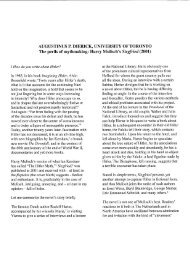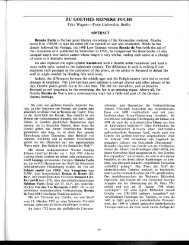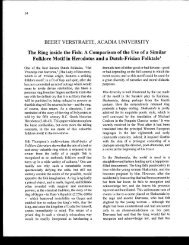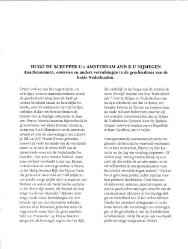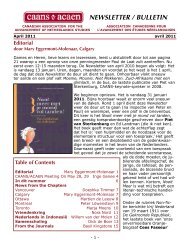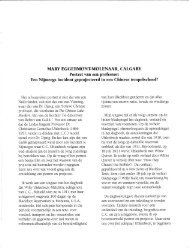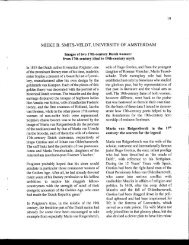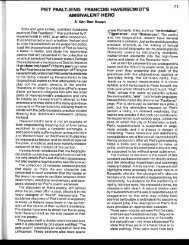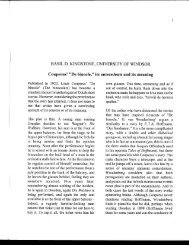THERESE DECKER and PETER G. BEIDLER - canadian ...
THERESE DECKER and PETER G. BEIDLER - canadian ...
THERESE DECKER and PETER G. BEIDLER - canadian ...
You also want an ePaper? Increase the reach of your titles
YUMPU automatically turns print PDFs into web optimized ePapers that Google loves.
1. Overview of the Scholarly Background on Nu<br />
noch by Therese Decker<br />
When my friend Peter G. Beidler, professor of<br />
English at Lehigh University, decided to make the<br />
Middle Dutch farce Nu noch the subject of study in<br />
his graduate seminar on "The Medieval Origins of<br />
British Drama" in the spring of 1994,he could not<br />
have received much encouragement from the two<br />
respected scholars who had translated the little play<br />
into English. Indeed, E. Colledge observes that the<br />
play has "no subtlety whatever" <strong>and</strong> "is the coarse,<br />
broad comedy of a society still close to the soil" (p.<br />
11). When Peter <strong>and</strong> his students first read the play,<br />
this dismissive evaluation of the literary merits of Nu<br />
noch seemed wholly justified, as he confesses in his<br />
part of this introduction. Yet he must have sensed<br />
something of quality in the little farce which P.<br />
Leendertz, the first editor, had also noted when he<br />
observed about Nu noch:<br />
De clute van Nu noch is ook weer zoo<br />
levendig gesteld, dat wij ze,<br />
niettegensta<strong>and</strong>e den zeer eenvoudigen<br />
inhoud, toch met genoegen lezen. Bij flot<br />
spelen zal zij niet nalaten de toehoorders in<br />
eene vroolijke stemming de brenghen. (p.<br />
clxviii)<br />
[The farce Nu noch is also constructed in<br />
such a way that we read it with pleasure, in<br />
spite of its very simple construction. If<br />
played in a brisk manner, it cannot fail to<br />
put the audience in a happy mood.]<br />
Indeed, long before Leendertz published the play in<br />
1907, H. E. Moltzer took note of the existence of the<br />
little farce in his 1862 history of the secular drama in<br />
the Netherl<strong>and</strong>s (pp. 144-45), <strong>and</strong> W. 1. A.<br />
Jonckbloet, writing in 1889, noted some of the<br />
positive qualities ofthe comedy. Jonckbloet, however,<br />
felt that he must apologize for the somewhat crude<br />
language of the play (vol. 2, pp. 380-81). Neither<br />
scholar submitted the farce to any detailed analysis.<br />
<strong>THERESE</strong> <strong>DECKER</strong>, MORAVIAN COLLEGE<br />
AND<br />
<strong>PETER</strong> G. <strong>BEIDLER</strong>, LEHIGH UNIVERSITY<br />
Introduction to Special Issue on Nu noch<br />
In 1887 Jan te Winkel, in his Geschiedenis der<br />
nederl<strong>and</strong>sche letterkunde, furnished a more detailed<br />
overview of the plot of Nu noch, but finally criticized<br />
the anonymous author for not having ended the play<br />
at the point where the husb<strong>and</strong> won his battle against<br />
his wife (p. 528). In 1897 Jan ten Brink suggested<br />
that many medieval farces had not been published<br />
because scholars were afraid of offending the public<br />
with the coarse language of these plays. Jan ten Brink<br />
himself was not discouraged by such views, <strong>and</strong> he<br />
published a short description of the plot of Nu noch<br />
(p. 237). In 1904, just three years before Leendertz<br />
published his monumental work on medieval drama in<br />
the Netherl<strong>and</strong>s, 1. A. Worp asserted that, while in<br />
general Middle Dutch farces depict women as horrible<br />
shrews, men as weak wretches, <strong>and</strong> the clergy as less<br />
than saintly, these comedies have artistic. value<br />
because they accurately depict lower class life in<br />
medieval times (vol. 1, pp. 98-99). And in 1907, G.<br />
Kalff gave a detailed description of the plot (pp. 359-<br />
61), <strong>and</strong> then commented:<br />
Welk een frischheid en welk een<br />
afwisseling zien wij hier, hoe weten deze<br />
stukjes [i.e., Nu noch <strong>and</strong> another farce<br />
called Klucht van Playerwater] ons te<br />
boeien, hoe goed zijn zij gebouwd, hoe<br />
aardig uitgewerkt, welk eene komiek van<br />
goed allooi! In beide zijn alleraardigste<br />
tooneeltjes; in. Nu noch b.v. de<br />
duivelbezwering, het eten van den<br />
pannekoek waarbij "nu nog" een nieuwe<br />
beteekenis krijgt, de overvalling der beide<br />
mannen door de gefopte vrouw (pp. 360-<br />
61).<br />
[What freshness <strong>and</strong> variation we see here,<br />
how these little pieces are able to captivate<br />
us, how well they are constructed, how<br />
nicely worked out, what an excellent quality<br />
of cQmedy. In both {comedies} we have the<br />
most charming scenes; in Nu noch, for<br />
example, the exorcism of the devil, the<br />
eating of the pancake whereby "nu nog"<br />
1
translation of Nu noch as it appears in this journal.<br />
The line numbers, given in parentheses after the<br />
quotations, will give readers direct access to the<br />
original language of the play in the lines facing the<br />
Decker translation.<br />
3. About this editiOn <strong>and</strong> translation<br />
For the Middle Dutch text we have followed as<br />
faithfully as possible P. Leendertz's 1907<br />
Middelnederl<strong>and</strong>sche dramatische poezie. Though we<br />
have indicated with ellipses lines he believed to be<br />
missing, we have not accepted his. suggested<br />
emendations.<br />
Like all translators, we encountered problems of<br />
usage <strong>and</strong> finding modem equivalents. In lines 64-65,<br />
for example, the all-too-helpful neighbor mutters to<br />
himself:<br />
ic warpe u eenen schoelap naer<br />
Dat ghij weI herden moed in dezen.<br />
It would have been singularly unhelpful if we had<br />
translated this literally <strong>and</strong> quite accurately as,<br />
I would throw a shoe sole after you<br />
if that would make you stick to this.<br />
Instead, we have rendered the passage more<br />
colloquially <strong>and</strong> less ambiguously, as<br />
I'd let you feel my boot<br />
if it made you stick to our plan.<br />
Perhaps the most important problem we faced was<br />
how to translate the oft-repeated phrase, "nu noch."<br />
The phrase makes little sense as a st<strong>and</strong>-alone phrase,<br />
though it might appear in a sentence such as,<br />
"Nederl<strong>and</strong>s wordt nu noch op Aruba gesproken."<br />
Adriaan J. Barnouw <strong>and</strong> E. Colledge, in their<br />
translation of the farce dated 1967, seemed to feel<br />
justified in translating this enigmatic phase as "say<br />
that again," though they do not explain their<br />
somewhat puzzling choice to the reader. Indeed, "nu<br />
noch" might be rendered in many different ways, such<br />
as "more than ever," as in "Now that I am on a diet,<br />
I want that piece of chocolate cake more than ever."<br />
Or it could mean "now still," "still," or' "even now,"<br />
as in "We still enjoy a good joke" or "Even now<br />
French is spoken in Haiti." The Middle Dutch phrase,<br />
Introduction to Special issue on Nu noch 5<br />
like these possible English equivalents, make sense in<br />
the context of a sentence, by themselves they are just<br />
what the author intended them to be, nonsense. The<br />
whole point of the phrase is that Jack's use of it<br />
proves that he is crazy. To make it into a complete<br />
sentence, like "say that again," is to destroy the effect<br />
of the nonsense-phrasty. After considerable discussion,<br />
we decided against the more common usages, such as<br />
"still" or "now stilI," partly because "still" can have<br />
many meanings, such as "quiet" (as in, "the waters are<br />
still" or "the still of the night"), or "to make quiet" (as<br />
in, "please still the child," not to mention "distillery"<br />
(as in "he was arrested for having a still in his back<br />
yard"). Hearing or reading "now still" might have<br />
tempted audiences to grope for levels of meaning<br />
where none was probably intended. In the end, we<br />
went with the translation "now again" as the one that<br />
to us best conveyed the nonsense of the original. We<br />
caution readers, however, that the translation is<br />
inexact, <strong>and</strong> invite other scholars to suggest more<br />
accurate translations.<br />
In an effort to keep our translation as accurate as<br />
possible, we have given a prose translation rather than<br />
a verse one. In a sense a verse translation would have<br />
been more faithful to the original, but our attempts to<br />
provide one required us to distort the meaning so<br />
much that it would have been misleading. We opted,<br />
instead, for a prose translation that would follow the<br />
meaning of the original as faithfully as possible, <strong>and</strong><br />
leave it to others to provide a versified translation that<br />
might better capture the sounds of the original.<br />
Although it might have been helpful to readers<br />
interested in putting on a production of Nu noch if we<br />
had supplied more elaborate stage directions <strong>and</strong><br />
scene divisions, in the end we decided not to do so.<br />
Such directions would have interrupted the flow of<br />
the dialogue, <strong>and</strong> would in any case have been our<br />
own intrusive interpretations. Only where we felt it<br />
was really necessary to avoid confusion did we<br />
indicate within square brackets where a character<br />
speaks in an aside. As for the scene divisions, any<br />
careful reading of Nu noch will reveal that there are<br />
four "scenes," perhaps acted on slightly different<br />
comers of whatever kind of stage the actors might<br />
have had access to. For us to have indicated or<br />
localized those, however, would have been stepping<br />
beyond our roles as translators.<br />
____________ __
6<br />
BIBLIOGRAPHY<br />
Baur, R., et al. Geschiedenis van de letterkunde del'<br />
Nederl<strong>and</strong>en. 9 vols. 's-Hertogenbosch:<br />
Teulings's Uitgeversmaatschappij, <strong>and</strong> L. C. G.<br />
Malmberg, Brussels: St<strong>and</strong>aard Boekh<strong>and</strong>el,<br />
1939-51.<br />
ten Brink, Jan. Geschiedenis der nederl<strong>and</strong>sche<br />
letterkunde. Amsterdam: Uitgevers-Maatschappij<br />
Elsevier, 1897.<br />
Colledge, E., ed., <strong>and</strong> Adriaan J. Bamouw, trans.<br />
Reynard the Fox <strong>and</strong> Other Mediaeval<br />
Netherl<strong>and</strong>s Secular Literature. Leyden, London,<br />
New York: Seijthoff, Heinemann, <strong>and</strong> Maxwell,<br />
1967.<br />
Jonckbloet, W. 1. A. Geschiedenis der nederI<strong>and</strong>sche<br />
letterkunde. Vol. 2. Vierde druk, herzien en tot<br />
den tegenwoordigen tijd bijgewerkt, door C.<br />
Honigh. Groningen: J. B. Wolters, 1889.<br />
Kalff, G. Geschiedenis der nederl<strong>and</strong>sche letterkunde.<br />
Vol. 2. Groningen: 1. B. Wolters, 1907.<br />
Knuvelder, G. P. H<strong>and</strong>boek tot de geschiedenis der<br />
nederl<strong>and</strong>se letterkunde. Vol. 1. s<br />
Hertogenbosch, L. C. G. Malmberg, 1948(6th17th<br />
ed, 1976-78).<br />
Leendertz, Pieter. Middelnederl<strong>and</strong>sche dramatische<br />
poezie. Bibliotheek van middelnederl<strong>and</strong>sche<br />
letterkunde. 2 vols. Leiden: A. W. Sijthoff, 1907.<br />
van Mierlo, 1. Geschiedenis van de oud- en<br />
middelnederl<strong>and</strong>sche letterkunde. Antwerpen,<br />
Brussels, Leuven: N. V. St<strong>and</strong>aard Boekh<strong>and</strong>el,<br />
1928.<br />
Moltzer, H. E. Geschiedenis van het wereldlijk<br />
tooneel in Nederl<strong>and</strong> gedurende de<br />
middeleeuwen. Diss. Leiden. Leiden: Gehroeders<br />
van der Hoek, 1862.<br />
______ . De middelnederl<strong>and</strong>sche dramatisch<br />
poezie. Bibliotheek van middelnederl<strong>and</strong>sche<br />
letterkunde. Vol. 1. Groningen: J. B. Wolters,<br />
1875.<br />
Canadian Journal of Nrtlwrhnriic Studies<br />
van der Riet, Frank G. Le thMtre profane serieux en<br />
langue flam<strong>and</strong>e au moyen age. La Haye:<br />
Martinus Nijhoff, 1936.<br />
te Winkel, 1. Gfischiedenis der nederl<strong>and</strong>sche<br />
letterkunde. Nol. 1 (no additional vols. were<br />
published). Haarlem: de Erven F. Bohn, 1887.<br />
Worp, J. A. Geschiedenis van het drama en van het<br />
tooneel in Nederl<strong>and</strong>. 2 vols. Groningen: 1. B.<br />
Wolters, 1904-08.
Introduction to Special issue on Nu noch 7<br />
A reproduction of the poster made by Sister Elaine Marie Glanz, a graduate student at University, advertising<br />
the production of Nu noch given on April 22, 1994, at Plymouth State College in Plymouth, New Hampshire.
8 Canadian Journal of Netherl<strong>and</strong>ic Studies<br />
The priest (played by Nancy Rodgers) tries to exorcise the demon that has driven Jack out of his mind, while the<br />
neighbor (played by Sheila Bauer) looks on. - Brian Ricker photo.
Introduction to Special issue on Nu noch 9<br />
The priest <strong>and</strong> the neighbor look on as Jack enjoys the delicious food prepared for him by his newly submissive wife.<br />
- Brian Ricker photo.
10 Canadian Journal of Netherl<strong>and</strong>ic Studies<br />
The wife, having discovered the plot against her, takes her revenge on the neighbor. - Brian Ricker photo.



